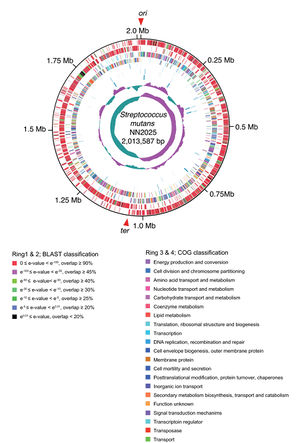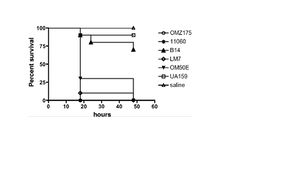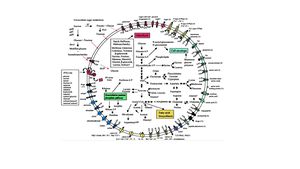Streptococcus mutans: More than Oral Pathogens
By: Jordan Wehner
Introduction
History
Our genetic code isn’t the only thing that is similar to chimpanzees, we also have oral microbes in common. Specifically, we share the firmicute Streptococcus mutans (Fig. 1). These pathogenic microbes are part of the bacteria kingdom and were first isolated from human cavities (carious lessions) in 1924 by ClarkeTemplate:Ref. The microbes received the name S. mutans because Clarke believed that the microbes were a mutant version of streptococcus. These microbes are found in all homosapiens and are the main cause of dental decay. As much as 90 % of the world is affected by this pathogenic microbe. XX
Serotypes
Like many species of bacteria, S. mutans have various strains and serotypes. Serotypes are microorganisms that share a shares a specific substance that cause an immune response.XX Four major serotypes have been discover so far. The serotypes are labeled as c, e, f, and k. The serotype c is considered to be the most common serotype found in plaque, making up about 80 % of the microbes population.XX The other three serotypes (e, f, and k) are less common. Up to 20 % of the S. mutans are considered to be e. The smallest groups, f and k, are thought to make up 5 % of the microbe population. Interestingly, the serotype k has only been isolated from Japanese individuals. Recent research has found that e, f, and k may play a hazardous role in infective endocarditis (e and f) and hemorrhagic strokes (k) even though they only make up about a quarter of the population.XX
Genome Structure
Currently, full genome sequences of two serotypes of S. mutans are known. The first to be sequenced was the c serotype. For the c serotype two strains have been fully sequenced, UA159 and NN2025.XX More recently, the genome of a serotype k was sequenced in Japan. This was done to learn more about its relationship with hemorrhagic stroke. XX The sequencing of the first S. mutans was published in 2002 and was the UA159 strain (c serotype).XX
It was isolated and sequenced in the United States. It was composed of a single circular genome with 2,030,0936 base pairs (Fig. 2). When sequencing the DNA they found that 36.82 % of the content was GC. This low GC content is consistent with the environment that S. mutans live in. The mouth, on average, is 20 – 40 oC and with a pH of ~ 7. This is important because if the oral cavity was more extreme a higher GC content would be needed to keep from destroying the DNA. The genome consists of 1,963 open reading frames (ORFs) organized so that both DNA replication and transcription are in the same direction. About a 1/5 of the ORFS are unique to the UA159 genome. Five rRNA operons and 65 tRNA sequences are located in the genome.
The strain NN2025 was the next strain to be fully sequenced and was published in 2009.XX This strain was isolated in Japan and was found to contain 2,013,597 base pairs (Fig. 3). The GC content of this strain was 36.85 %, very similar to that of the UA159 strain. The NN2025 strain contained 1,895 ORFs, 68 less than the UA159 strain. While the genome may be slightly smaller the genome also consists of five rRNA operons and 65 tRNA sequences. Both genomes contain sequences for the production of proteins and enzymes for the fermentation of sugars. When the sequences were compared their appeared to rearrangement in the genome.
With only about five percent of the S. mutans serotypes being k, it is not surprising scientists have not isolated and sequenced a k serotype until 2012. XX The strain was LJ32 and was isolated in Japan. This new serotype genome, like both the c serotypes, is composed of one circular genome. This genome consists of between 2,015,626 base pairs, similar to that of the c serotypes. The GC content in this strain is slightly higher than that of the c serotypes, 37.05 %. This strain contained the same rRNA operons and tRNA sequences. When the LJ23 sequence was paralleled with the UA159 and the NN2025, there was genomic rearrangement similar to that of the NN2025. This is believed to be due to the place of isolation, since the UA159 strain was isolated in the United States and NN2025 and LJ23 were both isolated in Japan.
Metabolism
Through the sequencing of the UA159 strain, scientists have been able to further understand the metabolic pathway and the proteins used for sugar fermentation without oxygen (Fig. 4).XX scientists believe that S. mutans The major sugar consumed by S. mutans is sucrose. The sugars metabolized by the microbe are converted to polysaccharides composed D-glucose monomers by glucosyl transferase.XX (http://2013.igem.org/Team:Northwestern/problem) These glucans allow the microbes in a colony to stick to each other along with the surface of the tooth. Many dentists refer to this as plaque. The glucans are then modified and cross the membrane by an ATP-driven transporter and broken back down to glucose. From here the sugars undergo glycolysis forming an end product pyruvate. The fermentation of pyruvate is S. mutans main source of energy. The pyruvate is fermented and the products are ethanol, formate, acetate, and lactic acid. Along with fermentation the cell has many other uses for intermediates and pyruvate, such as fatty acid synthesis, cell upkeep, and a non-oxidative pentose phosphate pathway. The acid products of the fermentation are then deposited in the environment surrounding the cell within a colony. By doing this, S. mutans allow themselves to keep their niche in the oral cavity by preventing other microbes from growing in the environment. S. mutans are able to keep homeostasis by having membrane bound proteins that uphold a nearly neutral intracellular pH.
Acid Production and Teeth
The fermentation and production of acid not only inhibits competition but also is the cause of dental caries. With hundreds of microbes living in every individual’s mouth it is hard to believe that one microbe is the major contributor to dental caries throughout the world. As the world continues to produce and consume more and more refined sugars dental hygiene becomes more important. As we continue to consume more sugars we begin to fuel the production of acids and accelerate colony growth and formation of dental plaque. The fermentation of the sugars to acids drops the environmental pH. It does not lower the pH of the entire mouth but just the area in which the colony inhabits. This is very important in order to understand how these microbes effect dental health. In order for the enamel and dentin of the tooth to remain rigid the tooth must be in an environment above a pH 5.5. When the colony ferments the pH drops below 5.5, the acids secreted by the microbes begin to demineralize the enamel causing the tooth to “rot.” The enamel is protects the dentin, root canal, and pulp chamber. The root canal allows for blood vessels and nerves to enter and exit the pulp chamber keeping the tooth healthy. When the S. mutans demineralize the enamel it begins to also irreversible destroy the dentin and could infect the pulp chamber. From there the microbes could enter the blood stream and travel throughout the body and kill the tooth. Once S. mutans are in the blood stream, scientists have discovered that the microbes may be more harmful than expected.
S. mutans "Attachment" to Your Heart
Include some current research in each topic, with at least one figure showing data.
The Correlation Between S. mutans and Hemorrhagic Stroke
Overall paper length should be 3,000 words, with at least 3 figures.
Conclusion
Overall paper length should be 3,000 words, with at least 3 figures.
References
Edited by student of Joan Slonczewski for BIOL 238 Microbiology, 2009, Kenyon College.






